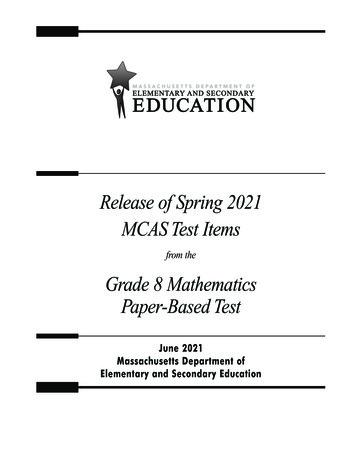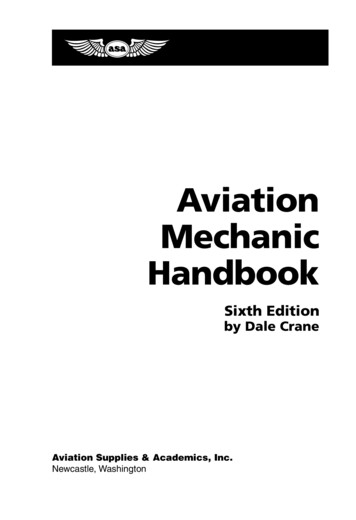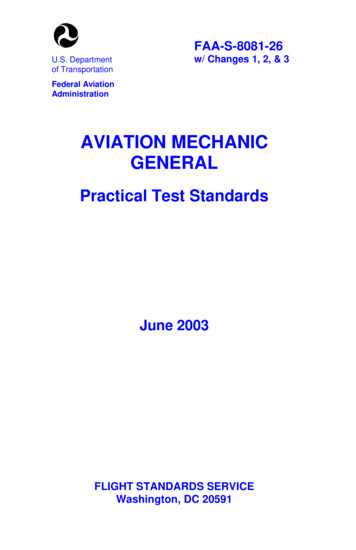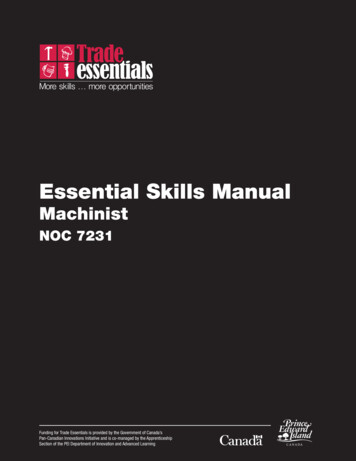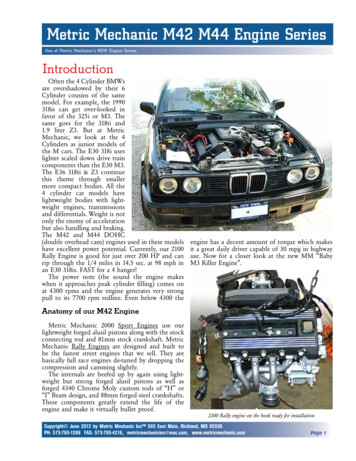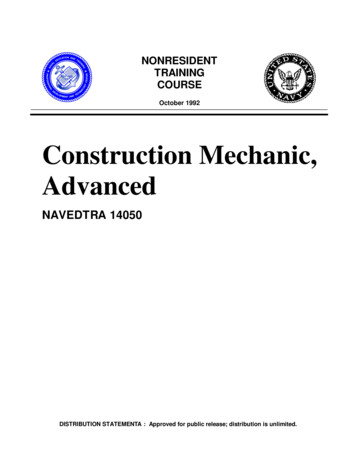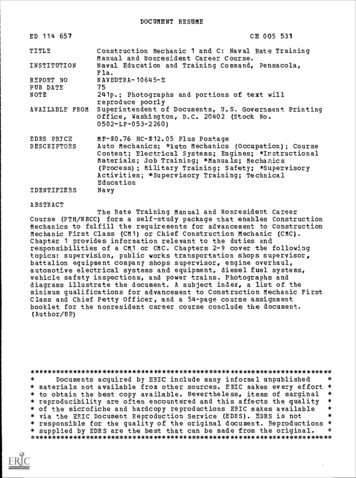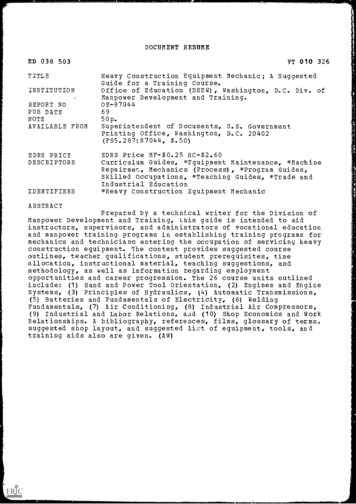
Transcription
DOCUMENT RESUMEED 038 503TITLEINSTITUTIONREPORT NOPUB DATENOTEAVAILABLE FROMEDRS PRICEDESCRIPTORSIDENTIFIERSVT 010 326Heavy Construction Equipment Mechanic; A SuggestedGuide for a Training Course.Office of Education (DHEW) , Washington, D.C. Div. ofManpower Development and Training.0E-870446950p.Superintendent of Documents, U.S. GovernmentPrinting Office, Washington, D.C. 20402(FS5.287:87044, .50)EDRS Price MF- 0.25 HC- 2.60Curriculum Guides, *Equipment Maintenance, *MachineRepairmen, Mechanics (Process) , *Program Guides,Skilled Occupations, *Teaching Guides, *Trade andIndustrial Education*Heavy Construction Equipment MechanicABSTRACTPrepared by a technical writer for the Division ofManpower Development and Training, this guide is intended to aidinstructors, supervisors, and administrators of vocational educationand manpower training programs in establishing training programs formechanics and technicians entering the occupation of servicing heavyconstruction equipment. The content provides suggested courseoutlines, teacher qualifications, student prerequisites, timeallocation, instructional material, teaching suggestions, andmethodology, as well as information regarding employmentopportunities and career progression. The 26 course units outlinedinclude: (1) Hand and Power Tool Orientation, (2) Engines and EngineSystems, (3) Principles of Hydraulics, (4) Automatic Transmissions,(5) Batteries and Fundamentals of Electricity, (6) WeldingFundamentals, (7) Air Conditioning, (8) Industrial Air Compressors,(9) Industrial and Labor Relations, and (10) Shop Economics and WorkRelationships. A bibliography, references, films, glossary of terms,suggested shop layout, and suggested lint of equipment, tools, andtraining aids also are given. (AW)
aAO00Ili!, 111II1a sutraininesteui e or acourse
DISCRIMINATION PROHIBITEDTitle VI of the Civil RightsAct of 1964 states: "No person in the United States shall, on the groundof race, color, or national origin, be excluded from participation in, bedenied the benefits of, or be subjected to discrimination under any program or activity receiving Federal financial assistance." Therefore, the;Vocational and Technical EdUcation and the Manpower Develop *tientand Training programs, like all other programs or activities receivingfinancial assistance from the Department of Health, Education, andWelfare, must be operated in compliance with this law.
0E-87044HEAVY CONSTRUCTIONEQUIPMENT MECHANIC(D.O.T. Occupational Code 620.281)A Suggested Guide for a Training CourseU.S. DEPARTMENT OF HEALTH, EDUCATION & WELFAREOFFICE OF EDUCATIONTHIS DOCUMENT HAS BEEN REPRODUCED EXACTLY AS RECEIVED FROM THEPERSON OR ORGANIZATION ORIG;NATING IT,POINTS Of VIEW OR OPINIONSSTATED DO NOT NECESSARILY REPRESENT OFFICIAL OFFICE OF EDUCATION.POSITION OR POLICY.U.S. DEPARTMENT OF HEALTH, EDUCATION, AND WELFAREOFFICE OF EDUCATIONROBERT H. FINCH, SecretaryJAMES E. ALLEN, JR., Assistant Secretary and Commissioner eif EducationBUREAU OF ADULT, VOCATIONAL, AND LIBRARY PROGRAMSGrant Venn, Associate CommissionerManpower Development and Training Program
Superintendent of Documents Catalog No. FS 5.287:87044U.S. GOVERNMENT PRINTING OFFICEWASHINGTON : 1969For sale by the Superintendent of Documents, U.S. Government Printing OfficeWashington, D.C. 20402 - Price 50 cents
ForewordThis guide has been developed to be of assistance to instructors, supervisors, andadministrators of vocational education and manpower training programs. It offerssuggested course outlines, shop layouts, and lists of equipment, tools, training aids,and their cost. The contents of this guide may be changed and adapted to meet thelocal needs of any vocational or manpower training program.This guide is, in part, the summation of contributions from:George 0. Anderson, Nebraska Vocational and Technical InstituteEarl M. Bowler, U.S. Office of EducationJ. W. Duncan, International Harvester CompanyRobert H. Engstrom, Darr Equipment CompanyMichael J. Matanich, Staples Area Vocational-Technical SchoolE. M. McKevitt, John Deere and CompanyJulian J. Smith, Caterpillar Tractor CompanyLee White, Darr Equipment CompanyThis guide was developed under the direction of F. J. Konecny, Assistant Directorof James Connally Technical Institute, for the Division of Manpower Developmentand Training. The course material was prepared by Charles E. McCoy, technicalwriter for the above-mentioned school.Recognition and appreciation is also extended to the many participating manufacturers, associations, equipment dealers, vocational and technical schools, and amilitary service school for the assistance they provided.HOWARD A. MATTHEWSDirector, Division of Manpower Developmentand TrainingGRANT VENNAssociate Commissioner for Adult, Vocational,and Library Programsiii
ContentsPageFOREWORDPURPOSEOCCUPATIONAL INFORMATIONORGANIZING AND TEACHING THE COURSECOURSE UNITSI. OrientationII. Hand and Power Tool OrientationIII. Shop Equipment and Mechanical Measuring DevicesIV. Engines and Engine SystemsV. Friction Clutches and Torque ConversionVI. Principles of Mechanical Linkage, Levers, and GearsVII. Sliding Gear TransmissionsVIII. Differential and Final Drives (Mechanical)IX. Principles of HydraulicsX. Hydraulic SystemsXI. Fluid Couplings and Torque ConvertorsXII. Automatic TransmissionsXIII. Brake and Booster SystemsXIV. Accessory Case Engine Driven Air CompressorsXV. Machinery Deck-Booms and AttachmentsXVI. Fundamentals of Piston Pumps and Pump SystemsXVII. Batteries and Fundamentals of ElectricityXVIII. Fundamentals of Electric Starting Motors and GeneratorsXIX. Electrical Regulators and ControlsXX. Welding FundamentalsXXI. Undercarriage and Wheeled VehiclesXXII. LubricationXXIII. Air ConditioningXXIV. Industrial Air CompressorsXXV. Industrial and Ltbor RelationsXXVI. Shop Economics and Work PENDIXESA. Suggested Training FacilityB. Suggested Equipment, Tools, and Training 29293032323334414143
PurposeThe purpose of this guide is to augment informationavailable through the Office of Education of theU.S. Department of Health, Education, and Welfarefor schools or institutions and manpower trainingcenters and to aid in the establishment of a trainingprogram for mechanics and technicians entering theoccupation of servicing heavy construction equipment.Existing schools and manpower projects can profitfrom this guide because it will provide informationfor reviewing and updating their programs.The guide is designed to assist school administrators,supervisors, and teachers who will be planning anddeveloping new programs or evaluating existingprograms in training heavy construction equipmentmechanics. Although the indicated level of instructionis post high school, the instruction can be adapted tostart at any level.This guide establishes suggested boundaries forteacher qualifications, student prerequisites, timeallocation, instructional material, and methodology.Information gathered regarding employment opportunities and career progression is also included.This program is designed to train school studentsand manpower project trainees to enter the labormarket with technical knowledge of pertinent equipment and general information in subjects relevantto the occupation. The training program encomand othercourses directly related and designed to increase thestudent's ability to succeed in this ever-increasingcomplex occupation. A student completing thisprogram will advance much faster than one learningon the job without prior training. As the equipmentbecomes more versatile and automatic, more skill isrequired to service it.Another training guide, more specialized in theindustrial engine area, is available and will supplement this guide as an aid to administrators, supervisors, and teachers. It is prepared in more detail todevelop skills in engine overhaul.passes applied mathematics, physics,
Occupational InformationThe following job description is quoted from TheDictionary of Occupational Titles:EngineeringEquipment Mechanic620.231. Heavy equipment mechanic. Analyzesmalfunctions and rebuilds, repairs, and adjustsheavy construction equipment other than internal combustion engines, such as cranes, powershovels, scrapers, paving machines, conveyors,and bulldozers; dismantles machine, using hoists,hand and power wrenches, screwdrivers, andpliers. Inspects parts for damage or excessivewear. Verifies that clearance and dimensions ofparts, such as shafts, bearings, bushings, pins,gears, and rollers meet factory specifications, usinggauges, such as calipers and micrometers. Directsassistant engaged in disassembly and assembly ofmachines and cleaning of parts. May specializein making field repairs to equip' vent sufficient toresume operation but not involving major overhaul or rebuilding and be designated as FieldMechanic.Employment OpportunitiesThe heavy construction equipment industry is anexcellent field for youths interested in a career inmechanics. The demand for mechanics in this areareading, working from schematics to troubleshoot, andthe ability to use service manuals and parts references.Automatic controls and drives being installed onmodern equipment have expanded the use of electricity, air, and hydraulics until mechanics have to becapable of more than simple mechanical functions. Agraduate from a heavy construction equipment schoolor manpower training course would have an advantageover untrained applicants getting started in themechanical field, and an ad(cd advantage of havinghad such adequate training is that his knowledge willincrease his advancement opportunities as experiencedevelops his skill.Salaries of mechanics in heavy equipment. servicesare above that of average mechanics working in general repair shops throughout the country. Outstandingmechanics in heavy construction equipment shopsenjoy better opportunities for advancement to betterpositions within the industry.A iurvey of many successful corporations was madeto determine what they think a student's qualificationsshould be for entering a training program. Thesefour qualifications were considered essential :Age: 18 years old by graduation date. Mature,with a capability of making intelligent decisionsfar exceeds the supply. Production of heavy construction equipment has increased an average of 20 percentannually for the past 6 years and estimates for yearsto come are even greater.because of the safety and economy factors essential to construction equipment service shops.Education: High school or equivalent; capable oflearning technical subjects made necessary by theOne manufacturer, producing 20 percent of theautomatic and remote control systems used onmodern construction equipment.machines manufactured of one type, did research todetermine how serious the mechanic shortage in theirfield service is. * He found that there was an immediatePhysical Condition: Students should have normalor corrected vision. They should have no physicaldemand for 2,334 mechanics in their dealerships ifhandicaps that would impair coordination orthey were available. Based on his figures, there wouldprevent their doing strenuous work for extendedperiods under adverse conditions, as is sometimesrequired. The student should be capable of liftingbe an estimated demand for 11,670 mechanics immediately in the dealership area. In addition to this,the need for mechanics in contractors' shops makes itheavy parts, and using mechanics' tools andeasy to realize that there is a critical shortage ofequipment.mechanics to service heavy construction equipment.Personal Attributes:The advanced technology of modern machinesrequires mechanics with knowledge directly related tothe industry of heavy construction, such as blueprint*Survey conducted by Fred Hileman of John Deere &Company.2Students should be alert,courteous, cooperative, and dependable as evidenced by school records or previous employment. The student should show aptitude (determined by tests) for working successfully as amechanic.
Organizing and Teaching the CourseTeacher QualificationsTraining FacilityTeachers of vocational-technical programs shallhave a minimum of 3 years a uccessful occupationalexperience beyond apprenticeship, post high school,plus 60 clock hours of teacher training before em-Suggestions are included to assist in establishing aprogram along with a list of tools, equipment, andsupplies essential to a heavy construction equipmentmechanic training facility.ployment, and have graduated from appropriatetrade schools or, if military, from appropriate serviceschools.The teacher should have a pleasant personalityand should be in good health. He should be adeptat presenting technical matter and demonstratingoperations the students will be expected to performin the occupation.Teaching ProceduresOrganized lectures are necessary for introducingmost subjects, but the emphasis should be on shopexperience with as much student participation aspossible.The resourceful teacher can use this guide toprovide students with the maximum learning possiblein preparing them to enter the occupation of heavyconstruction equipment mechanic, which includesworking with many different pieces of equipment.The suggested times for instruction will vary withthe collective background of the students. The instructional topics in each unit are suggested to betaught in blocks, with specific suggestions includedwith each unit along with suggested student assignments for that phase of instruction.Lesson planning is the responsibility of the instructor, with the guide furnishing a suggestedsequence for presenting the subject items included.A teacher in each area of training should evaluatethe students' progress to determine if they haveadvanced sufficiently to permit the introduction ofnew material. Included in the manual is a sampletest which might be used as a pattern for testing thestudents. The teacher should also devise practicalmeans of evaluating students' progress as they perform assignments.A qualified teacher should be able to set up acomplete program and teach the course effectivelywith these units as a guide.ClassShoproomTitleUnitI. OrientationII. Hand and Power Tool Orientation . . . .III. Shop Equipment and MechanicalMeasuring DevicesIV. Engines an I Engine SystemsV. Friction Clutches and Torque ConversionVI. Principles of Mechanical Linkage,Levers, and GearsVII. Sliding Gear TransmissionsVIII. Differential and Final Drives (Mechanical)IX. Principles of HydraulicsX. Hydraulic SystemsXL Fluid Couplings and Torque ConvertorsXII. Automatic TransmissionsXIII. Brake and Booster SystemsHours 20204020401861515154545456020451030XIV. Accessory Case Engine Driven AirCompressorsXV. Machinery Deck-Booms and AttachmentsXVI. Fundamentals of Piston Pumps andPump SystemsXVII. Batteries and Fundamentals of ElectricityXVIII. Fundamentals of Electric StartingMotors and GeneratorsXIX. Electrical Regulators and ControlsXX. Welding FundamentalsXXI. Undercarriage and Wheeled Vehicles. . .XXII. LubricationXXIII. Air ConditioningXXIV. Industrial Air Compressors .XXV. Industrial and Labor RelationsXXVI. Shop Economics and Public Relations .11Total1, 3503851-940 0 69-2
Course UnitsUnit 1ORIENTATIONTraining TimeClassroom, 3 hours; shop, 3 hoursObjectivesTo introduce students to the heavy construction equipment mechanic occupation, type of working con-ditions that might be expected, and the rewards ofsuccessful training.To develop working procedures for preventing injuryto self or others, as well as preventing damage tomachines and equipment.To explain shop rules governing student behavior,and reporting procedures for hazardous conditionsdetected, or accidents, if any.To establish policies and procedures for students inthe class and shop.Unit OutlineA. Introduction to occupation1. Guest speaker to outline, "A Career in theHeavy Equipment Industry"2. Industry background film, "Use of Machinesin Our Industrial Life"B. Personal safety1. Student responsibility in individual andgroup activities2. Student behavior and safe attitudes3. Handling heavy or bulky itemsa. Manual lifting techniquesb. Lifting techniques with hoisting devicesc. Hand signals for hoisting or movingequipment4. Protective measuresa. Appropriate attireb. Protective devices, such as safety glassesc. Qualifications to operate machines andequipmentC. Shop precautions1. General operating procedure for each pieceof equipment42. General procedures for assigned jobsa. Preferred shop proceduresb. Safety precautions to be observedc. Use of hoists, welding equipment, andgrinders in a manner safe for self andothers3. Fire precautionsa. Housekeepingb. Oil rag containersc. Fuel and oil storage(1) Color code(2) Markingd. Fuel and oil handling for jobs4. Firefighting equipmenta. Locationb. OperationD. Accident prevention1. Reporting hazards and accidents2. Safety inspectionsE. Occupational practices in training1. Classroom policiesassignments, tests, notebooks, guest speakers, and field trips2. Shop proceduresa. Equipmentuse and careb. Job assignmentsTeaching SuggestionsInvite a guest speaker who has attained success inthe heavy construction equipment industry togreet the students, and show a film on the manufacture or servicing of the equipment.Show safety film to illustrate how hazards can disablefor life and how accidents happen. Practice orconduct drills to make certain the students aredeveloping good safety habits.Demonstrate how to use stands under vehicles whenworking under them and have the students practice putting a vehicle on stands.Show a film or demonstrate the proper use of thefirefighting equipment installed in the shop and ofthe types of fires that are related to heavy construction equipment repair shops.
Student AssignmentsGive the students a written and practical examina-tion, requiring they pass it with a satisfactorymark; file results in their records. Make the testcomplete and comprehensive to show proof ofnonnegligence that might result in legal actionfrom an accident.ReferencesKates. Diesel and High Compression Gas Engines.Williams. Accident Prevention Manual for Shop Teachers.FilmsBasic Shop Safety. Jam Handy Organization.Roll of Drums. Caterpillar Dealer.Senior Safety Series. McGraw-Hill.Use of Machines in Our Industrial Life Series. McGrawHill.Unit IIHAND AND POWER TOOL ORIENTATIONTraining TimeClassroom, 3 hours; shop, 9 hoursObjectivesTo teach the student tool nomenclature and how toselect, use, and maintain such tools.To acquaint students with power tools common toheavy construction equipment service shops, anddevelop the students' ability to use them safely andproperly.Unit OutlineA. Safety factors1. Mushroom heads on chisels, punches, andother impact tools2. Screwdriver hazards3. Tools in poor conditiona. Hammer handles looseb. Defective tools4. Eye protectionB. Application and maintenance of tools1. Wrenchesa. Ratchets, sockets, and extensionsb. Torque and torque multipliersc. Adjustabled. Boxe. Open-endf. Spanner2. Pullersa. Handb. Power3. Taps, dies, reamers, and extractors4. Tube cutting and flaring sets5. Pliers and lock-ring tools6. Screwdrivers, chisels, and punchesa. Grinding mushroom headsb. Grinding working edges7. Hammers, all types8. Hacksaw frames and bladesC. Power tools1. Safety precautions for operating2. Electrical grounds3. Power drilla. Drilling operationsb. Reaming operationsc. Honing operations4. Portable sanders, grinders, and buffers5. Pedestal and bench grinders6. Impact and vibrator tools7. Clamping or securing jobs for power tooloperationsTeaching SuggestionsDisplay and name each tool and explain uses for each.Discuss quality, maintenance, and storage eachtime a new tool is introduced.Demonstrate proper application of hand tools andexplain how torque should be applied, forinstance, in using the adjustable open-end wrench.Explain systematic procedure for inspecting powertools. Have students participate in oral discussionsof all power tools and stress the importance ofsuch points as air hose fittings and the danger of aloose air hose, or an electrical arc in an ungroundedtool.Demonstrate grinding mushroom head from a chiselor punch, and how to grind working edges of chisels,drills, and punches.Student AssignmentsPlace a variety of tools on a work bench and haveeach student identify the tool, including its size,where appropriate.Have each student practice with a hammer and chiselby splitting a nut off a bolt in a prepared mock-up.Have each student check an electric drill, clamp ax 132" round stock in a vise, center punch oneend, and drill a hole through it lengthwise to seehow near the center of the stock he can come outthe opposite end.5
ReferencesCrouse. Automotive Mechanics, chapter 2, pp. 1-21.General Motors. ABC of Tools.Snap-On-Tools Corporation. How's Tour 'SafetyRating'.Unit IIISHOP EQUIPMENT AND MECHANICALMEASURING DEVICES2. Calipersa. Inside and outsideb. Transferring readings with calipers3. How to use and read micrometersa. Outside micrometerb. Inside micrometerc. Depth micrometer4. Use of gaugesa. Feeler gaugeb. Thread gaugec. Radius gauge5. How to use the dial indicatorTraining TimeClassroom, 3 hours; shop, 3 hoursTeaching SuggestionsInvite a guest speaker professionally employed inObjectivesaccident prevention.To develop the student's ability to use repair equipment common to heavy construction equipmentshops safely and effectively, without endangeringhimself or the equipment.To develop an understanding of the application ofmeasuring devices used to service or repair construction equipment.Demonstrate to the class, in the shop, the properUnit OutlineA. Safety factorsguest speaker : "Typical AccidentsStudent AssignmentsCausing Time Loss"B. Shop equipment applications1. Jack nomenclaturestands, as though they would work under it; thenhave them lower it back to the floor.Have a team demonstrate use of a hoist and practicea. Mechanicalb. Hydraulicc. Air, and air-over hydraulic2. Practical application of jacksa. For placing equipment on standsb. For positioning and aligning components3. Hoist nomenclaturea. Overhead installations, fixed and railb. Floor, installed and mobile4. Press nomenclaturemethod for using each piece of equipment. Promoteclass participation as demonstrations progress.Use the various measuring devices on actual equipment to demonstrate their purposes. Then introducethe principles of each measuring device, how toread each accurately, and how to care for each.Have student team practice putting a vehicle onhand signal drill.Have a team demonstrate use of a press.ReferencesCaterpillar Dealer. Proper Use of slacks, Cranes, Presses,Pullers and Chains.Crouse. Automotive Mechanics, chapter 1, pp. 22-26.Nichols. Heavy Equipment Repair, chapter 11, pp.289-317.Williams. Accident Prevention Manual for Shop Teachers.a. Hydraulicb. Mechanical5. Press applicationsa. Positioning for assorted job sizesb. Clamps and jigs for assorted job types6. Parts cleaning equipmenta. Solvent unitsb. Steam systemsC. Mechanical measuring devices1. Scales or common rulea. Decimals and fractionsb. Machinist's square and protractor6Unit IVENGINES AND ENGINE SYSTEMSTraining TimeClassroom, 50 hours; shop, 110 hoursObjectivesTo develop the student's understanding of the principles of two- and four-cycle engine operation. To
acquaint him with the nomenclature of each type,and applications for each design.To develop an understanding of those systems necessary to make the engine perform as designed, suchas: cooling, fuel, ignition, and how to troubleshoot and correct malfunctions.Unit OutlineA. Safety factors1. Precautions to keep self or clothing clear of arunning engine2. Hazards of accidentally grounding electricalcircuits by tools or jewelryB. Four-cycle gasoline engines1. Operating principles of the four-stroke cycle2. Engine nomenclaturea. Stationary partsb. Moving partsC. Two-cycle gasoline engines1. Operating principles of the two-stroke firingcycle2. Engine nomenclaturea. Stationary partsb. Moving partsD. Two- and four-cycle diesel engines1. Similarity of gasoline and diesel engines2. Operating principles of four-cycle dieselenginesa. Natural scavengingb. Mechanical scavenging and supercharging3. Operating principles of two-cycle diesel enginesa. Two-cycle engine blowers and super-.chargersb. Comparison of two- and four-cycleenginesE. Engine systems1. Ignitiona. Principles of battery ignition circuitsb. Distributor nomenclature; fundamentals and timingc. Fundamentals of spark plugs, ignitionwiring, and ignition switches(1) Heat ranges and construction(2) Two- and four-cycle engine plugsd. Definition of a magnetoe. Principles of creating the sparkf. Magneto nomenclature and timingg. Magneto servicing and troubleshooting2. Carburetiona. Principles of one-, two-, and four-barrel carburetionb. Identification and operation of carburetor circuitsc. Service adjustments and specifications3. Diesel fuel injection systemsa. Fuel injection pumps; nomenclatureand operating principlesb. Fuel filtersc. Injection nozzlesd. Unit-type injectorse. Governor operating principles and fuelinjector timingServicingand troubleshooting procef.dures4. Turbochargers and blowersa. Nomenclature and operating principlesof turbochargersb. Nomenclature and operating principlesof blowersc. Synchronization and lubrication principlesd. Failure analysis and testing procedures5. Liquid engine coolinga. Fundamentals of cooling systems(1) Conduction(2) Convection(3) Radiation(4) Temperaturepressure relationshipb. Components of cooling systemsc. Coolants and precautions to protectwater jackets, radiators, and pumpsd. Principles of air coolinge. Heat dissipatingfins,shrouds, andbafflesf. Service procedures and troubleshootingTeaching SuggestionsExplain the precautionary procedures when workingon engines that are running, such as how an auto-matic transmission might accidentally get intodrive positions, tools, wiping rags, or clothingcaught in moving parts. Also caution students tokeep fingers clear of moving belts.Prepare a checklist for types of equipment, and traineach student to use it prior to starting work;to precheck, prior to cranking any engine; andto put a piece of equipment in motion.When teaching principles of engine systems, use thecomponents of actual equipment in your shop,augmented by material from the manufacturers.7
Student AssignmentsTest each student as he completes a checklist forcranking and moving a piece of equipment and forworking on the engine.Have student team take compression readingson a gasoline and a diesel engine, respectively, andexplain what can be determined fromthesereadings.Remove the ignition wires from an engine and haveeach student team properly reinstall them.Have student team remove, reinstall, and test aC. Friction clutches1. Definition and requirements of a clutch2. Principle parts of a clutcha. The driving membersb. The driven membersc. The operating members3. Types of clutchesa. Dry single-plate clutchb. Dry multiple-disc clutchc. Wet- and dry-band clutches, and planetary applicationsd. Wet single-plate and multiple-discclutchescarburetor of a functioning engine.e. Dog or finger clutchesReferencesCaterpillar Dealer. Cooling SystemTemperature andPressure.Caterpillar Dealer. Pneumatic Pressure Ratio Control.Crouse. Automotive Mechanics, chapters 5 and 6,pp. 84-146.Nichols. Heavy Equipment Repair, chapter 4,104 and 109-135.Teaching SuggestionsEmphasize the importance of making sure an enginecannot start when moving the flywheel and turningthe engine.Use mockups or cutaway models to illustrate thePP. 93Unit VFRICTION CLUTCHES AND TORQUEprinciples of the various types of clutches mentionedin this unit.Demonstrate disassembly and reassembly of clutcheswith actual assemblies of equipment, emphasizingprecautions to practice as each step is demonstrated,and adjustment.CONVERSIONStudent AssignmentsTraining TimeClassroom, 35 hours; shop, 25 hoursObjectivesreassembles a clutch pack for a practical evaluationscore.ReferencesTo develop the student's understanding of clutchprinciples and their application to heavy construction equipment.To develop the student's skill with the various clutchtypes, their components, and power transmission orinterruption, from a constant rotating input.Unit OutlineA. Observe safety factors1. When rotating the flywheel, in removal, or inreplacement of pressure plate bolts2. When removing or replacing clutch assem-bly to prevent damage to self or to theequipmen.B. Principles of torque conversion1. Mechanical principles2. Fluid principles8Observe each student team as it disassembles andCrouse. Automotive Mechanics, chapter 19, pp. 426-442.Nichols. Heavy Equipment Repair, chapter 6, pp.175-198.Unit VIPRINCIPLES OF MECHANICAL LINKAGE,LEVERS, AND GEARSTraining TimeClassroom, 18 hours; shop, 12 hoursObjectivesTo develop student understanding of the principlesof mechanical linkage, leverage, and gears, as used
throughout heavy construction equipmentfromthe smallest components to the most powerfulbooms.Unit OutlineA. Safety factors1. Precautions to take for personal safetya. Procedures to protect hands and fingersb. Removal of rings, watches, etc.2. Precautions to protect equipmenta. Clean working habitsb. Filters and strainersB. Levers and gears1. Energy, work, and mechanical advantage2. Rocker arms and bell cranks3. Gear ratio for power and for speed4. Related math for lever and gear applications(see figures 1 and 2)C. Mechanical linkage1. Relationship of cams and eccentrics topushrods and rocker arms, as exemplifiedin an overhead valve system2. Pedal to link, to crossover bar, to leverprinciples, as utilized in a clutch assembly3. Principle of gearshift shaft, to lever, tolinkage, to lever; back to shaft4. Principles of linkage and levers to controlother components, such as:a. Boom arran
Mechanic. Employment Opportunities. The heavy construction equipment industry is an excellent field for youths interested in a career in mechanics. The demand for mechanics in this area. far exceeds the
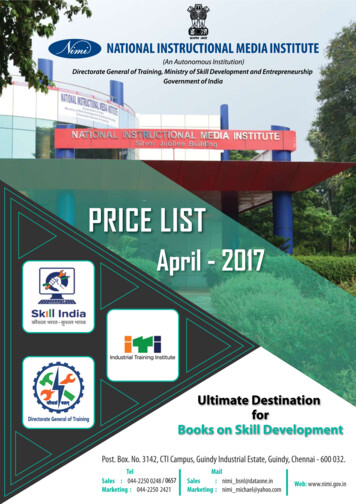

![Motorcycle Mechanic [MM] - CTEVT](/img/5/motorcycle-20-20mechanic-2010.jpg)
